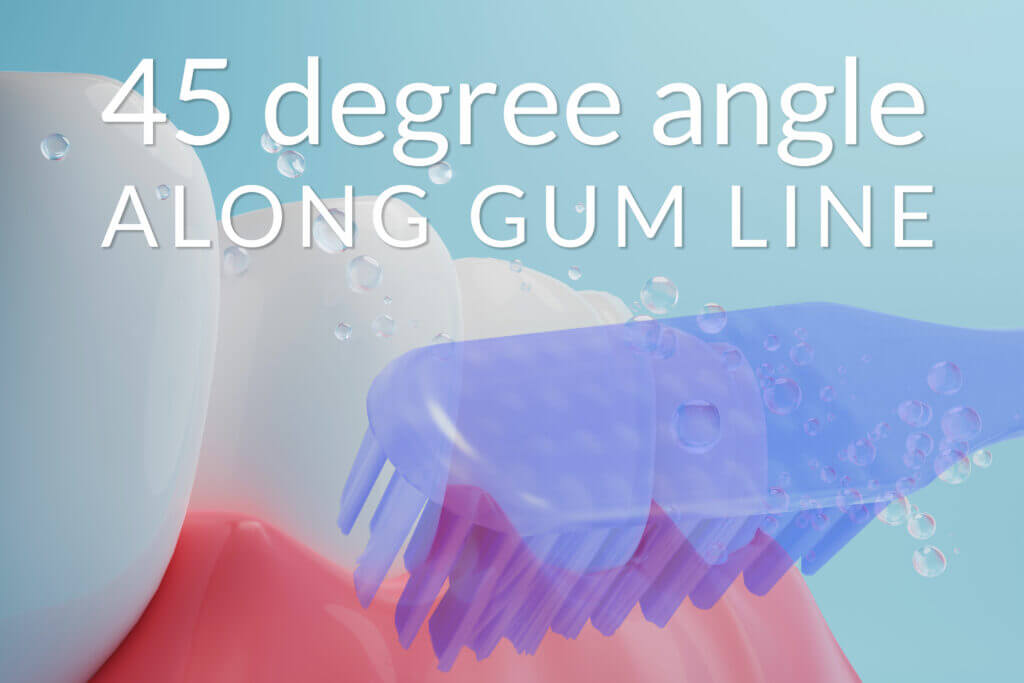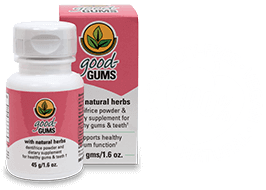At first there’s no sign that the gums you see lying against the roots of your teeth have slowly become detached and are no longer so firmly attached to the teeth. Then you may notice bits of food, like little seeds, start getting stuck in the crevices between your teeth and gums. Eventually a dentist or dental hygienist may confirm that your gum tissue is progressively becoming detached from the roots and you start to feel worried you may lose teeth. Do you dread going to the dentist to find out your pockets are getting worse? Do you feel helpless, unsure of what to do?
You’re not alone, this condition affects millions people, even those conscientious about their oral health.
Don’t worry! Good-Gums is here to help!
The ingredients in Good-Gums are specifically designed to support your body’s natural tendency to heal itself. Many people who have used Good-Gums have found that their condition has improved, and in some cases have even made their trip to the periodontist unnecessary. There’s cause for hope that there is a much cheaper, less painful option to try before resorting to expensive and intrusive procedures, and you’ll feel more knowledgeable and in control of your oral health.
Edie KI’m so excited, I had to tell you that with Good_Gums and regular flossing and water picking, I have reduced my gum pockets from 7s to 2s and 3s. Thank you for your wonderful product!*

What does it mean to have gum pockets?
Typically the first indication that you have gum pockets comes when a dentist or dental hygienist slides that little measurement-probe between your teeth and gums and reports how deep your gum pockets are. When gum cells start detaching from the tooth, the little crevice stating at the collar of the gum line deepens enough to form a pocket and can proceed right down to the periodontal ligaments that hold the tooth in place. There’s usually no visual indication—the gums continue to lie against the tooth, even though they’re losing their attachment—and there’s usually no pain associated with the gradual deepening of a pocket. But it is a manifestation of periodontal disease (“around the tooth” disease) which started off as gingivitis (literally an inflammation of the gums from gum infection). Gum pockets should be taken seriously and addressed to prevent tooth loss.
If the condition persists, and turns into gum pockets, the infection will progress deeper into the tissue alongside the tooth, eventually killing cells that support the tooth, such as periodontal ligaments and even jawbone cells. Periodontal disease in its various forms is the most common path to tooth loss.
All expressions of periodontal disease and gingivitis share the same underlying dynamic, even though the most effective way to address each particular manifestation can be a little different.
General dynamic of gingivitis: typically this means that a chain of events has led to your gums being infected. Plaque-forming bacteria have collected at the gum line (where the teeth and gums meet), gathered yeasts and other materials, and formed a soft mat of biofilm called plaque, to more effectively reproduce and absorb nutrients from the food in your mouth. The plaque gives off acidic wastes and calcifies into a hard mineral deposit called tartar (or calculus) that is “cemented” firmly onto the teeth. The acid-soaked calculus irritates the gums enough to cause lesions through which bacteria can enter and infect the interior of the gums. The body’s response to the infection is inflammation, an attempt to kill the invading bacteria, but infected gums cells also die in the process.
Let’s see how Good-Gums can help!
Willie FThe spaces that measured 4 or 5 are now 1 or 2. It took awhile for me to develop this major problem and it has taken awhile for the pockets to tighten up. I was told by the dentist that I would lose my teeth. Ha – not so … I have not lost a tooth!!!! If you truly want to keep your teeth or you know someone with problems, please share this product. You and they will sing it’s praises.*
How our combination of SCIENTIFICALLY BACKED ingredients help:
Good-Gums is specifically formulated for gums with clinically proven ingredients of the highest purity and potency. It works with your body’s natural processes, whose predisposition is to heal and nurture. Good-Gums takes advantage of two facts about your gums: their cells have some of the fastest replacement rates in your body, and they are comprised almost entirely of connective tissue. In most of the body a cell lives for an average of 7 to 10 years before being replaced, while a new gum cell is replaced after only 7 to 14 days. Healthier gum cells can start replacing less-healthy cells quickly, if they are given what they need. What new gum cells need is what all connective tissue cells absolutely rely on for their formation: a large amount of vitamin C. Good-Gums is unique in providing a healthy amount of vitamin C, plus citrus bioflavonoids that help the body utilize the vitamin C. Check the labels: other products (whether pastes. balms or essential oils) just don’t provide it. The Good-Gums formula dissolves right in the mouth to be absorbed directly by the gums, where it’s needed the most.
The Good-Gums formula also contains a lot of alkaline baking soda to buffer the acidity of its vitamin C, thereby protecting your enamel from acid erosion. To keep the alkaline baking soda from reacting with the acidic vitamin C in the bottle, the entire formula is kept in a dry powder state. When the powder meets saliva in your mouth, it becomes a liquid solution that starts getting absorbed by the gums immediately before these two ingredients (alkaline and acidic) could react or could weaken the vitamin C.

Good-Gums is absorbed more easily by the inclusion of French grey sea salt in our formula, which has a mineral balance similar to human-produced fluids (so much so, that it was successfully used in place of blood for transfusions to some wounded sailors in WW-II, when blood wasn’t available). This matching mineral composition avoids an ion imbalance that would otherwise stop absorption through cell membranes. Since more of the Good-Gums solution can be absorbed, it can do its work quicker and better.
Besides supporting the growth of healthier new gum cells, Good-Gums also has herbal ingredients that soothe sore gums. Myrrh and peppermint are famous for their soothing properties. Cinnamon is a potent anti-inflammatory. And salt solutions are so soothing as to be the standard recommendation by dentists after oral surgery. All are carefully-selected ingredients of Good-Gums.
To help control the population of the plaque-producing bacteria, peppermint, myrrh, and cinnamon act as natural antimicrobials. Baking soda, besides buffering the acidity of vitamin C, also makes the oral environment less favorable for the proliferation of acid-loving, plaque-producing bacteria.
To help remove plaque from constant contact with the gum margins (where they can re-infect the gums), Good-Gums employs the extraordinary property of cranberry, which significantly loosens the grip of plaque bacteria on the nanoscale, so that it the plaque bacteria can more easily be removed by the mechanical action of toothbrush bristles and floss.
Your gums can improve by the combination of these three strategies: by our unique active nutritional support for the formation of healthier new gum cells, by soothing sore tissue while your gums are recuperating, and by reducing the excessive numbers of and contact by infectious agents.
Try it and see for yourself…

Healthy teeth and gums – for life!
Good-Gums goes to work straight away. Feel the difference as our unique formula – containing everything gums need to heal and restore – takes effect.
During the first one or two bottles, you are likely to notice a definite improvement to your gums. They may feel firmer and tighter. If your gums had previously been bleeding at times, they probably will have stopped. Previous sore spots may no longer feel sore… all encouraging signs that you’re on the right path.
But that’s just the start…
Our goal for you is to have fully restored, healthy gum tissue firmly reattached to your teeth, tight gum pockets and no inflammation or irritation, soreness, infection or bleeding – ever again.
And as thousands of customers already know – with Good-Gums it’s possible!
That’s why we recommend that you keep up the good work and continue with an oral care routine featuring Good-Gums for life, so your teeth and gums continue to benefit from our combination of effective natural ingredients.
So invest today in healthy teeth and gums for life with Good-Gums.
Ways to use Good-Gums for Gum pockets:
The way in which your gum problem manifests and where it manifests within the structure of the mouth determine the most effective way to apply Good-Gums. The location of the gum pockets problem is relatively hidden, and when they’ve become quite deep they can be fairly inaccessible, so addressing them may require more than routine practices against gingivitis. Even so, it’s important to remove plaque from the gum margins (so that it won’t calcify into calculus or cause future infections). There are three most common ways to apply Good-Gums to accomplish this: with a toothbrush, with floss and with an interdental (interproximal) brush. These are the same implements commonly used for daily hygiene, but the techniques for applying Good-Gums are a bit different, in order to accomplish more than just cleaning teeth. These three also help to massage the Good-gums solution into the gums at the same time. This is key to support the body’s ability to heal from the inside. Detailed instructions on how to use Good-Gums come with your shipment.
Toothpaste shouldn’t be used within the four hours before using Good-Gums, because toothpaste contains glycerin which can leave a filmy coating on the gums that seals the gums from absorbing the herbal solution.

APPLYING GOOD-GUMS WITH A TOOTHBRUSH
Our recommended way of applying Good-Gums with a toothbrush loosens plaque and brushes away loosened debris, disrupting plaque that has formed on the outside and inside flat sides of the teeth. But our method also massages the gums at the same time, helping them absorb the herb-and-vitamin formula that supports healthy gum function. Detailed instructions on how to apply Good-Gums most effectively with a toothbrush come with your shipment.
A tooth brush is an essential tool for breaking up plaque on the front (outer) surfaces and also the back (inner) surfaces of teeth. But Good-Gums uses a slightly different technique than brushing with toothpaste. That’s because toothpaste relies on the abrasives in it to grind away plaque, which is somewhat effective at reducing plaque, but which also grinds away molecules from the surface of tooth enamel. But toothpastes fail to provide any direct support to the growth of healthy new gum cells. Good-Gums does support the growth of healthy new gum cells (through its buffered vitamin C), and it’s also effective at removing plaque, but not by any abrasives. Instead Good-gums employs an herbal ingredient that relaxes bacteria’s adhesive grip, so that the toothbrush can more easily remove the plaque.
The Good-Gums technique is to dissolve some Good-gums powder in saliva to form a liquid solution, and then to angle the brush 45-degrees, to slide some of the bristles into the crevice between the gums and the root of a tooth, and then to wiggle the brush head in tiny circles so that the bristles in the crevice move to and fro. This massages the gums for better absorption.
Toothbrushes intended for use with abrasive-laden toothpaste are relatively hard, even when they’re labeled “medium” or “soft; but with Good-Gums we use an “extra-soft” toothbrush. Instead of using a toothbrush to grind abrasive paste into where plaque forms, a toothbrush is used to massage a dissolved solution of Good-Gums into the plaque and into the gums as well; then the brush sweeps away the loosened debris. Electric toothbrushes can be used with Good-Gums; they almost always come with extra soft bristles.
Flossing
Flossing with Good-Gums (if done properly) is a good way to remove plaque from between the teeth, where a toothbrush can’t reach, while also transferring dissolved Good-Gums below the gum line. Proceed very slowly and gently for the first few days, as your gums may be sore and sensitive, or even bleed. Day by day your gums will get a little more resilient. Put a small pinch of Good-Gums in your mouth and swirl it to the first section (e.g., upper left) that you’ll floss. Move the floss between two teeth (do not snap into place). Then position the floss as deeply as you can into the gum line, pull it tightly around one side of the tooth, and scrape from the root toward the crown. Do not use an in-and-out sawing motion. Floss all the way under the gum line, and the dissolved Good-Gums solution will be moved under there as well. Then halfway-wrap the floss around the side of the other tooth and scrape its plaque loose. Remove the floss and move it to the next split between teeth to floss the sides of those two teeth. When one section is done, take another small pinch of Good-Gums and repeat the process.
Interdental brushes
Because gum pockets are an indication of an underlying history of periodontal disease, it’s important to remove as much plaque as possible from the sides of the teeth. A way to remove even more is with an interproximal brush (sometimes called an interdental brush or proxabrush). It’s a small plastic or wire rod with little bristles spiraling around one end of the rod. Put a small pinch of Good-Gums in your mouth, where it will dissolve, swish it to a section of teeth and move the interproximal brush in and out between teeth, using the spiraled bristles to massage the dissolved Good-Gums into the gums. This practice is particularly beneficial for addressing gum tissues that have detached and have formed pockets on the ides of teeth.
Soaking the gums around a troubled spot
A good way to use Good-Gums is to let it sink into the tissues, folds, and crevices of a troubled spot for a longer time than the exposure from the above steps.
• Put a small pinch of Good-Gums into your mouth and let it dissolve.
• Swirl it over any areas of particular concern and hold it to let the liquid cover the problem area.
• Gum tissues do absorb quite readily, so let the Good-Gums stay there for a few minutes.
Supragingival oral irrigation
Oral irrigation is an additional step beyond the toothbrush, floss and interdental brushing. Gum pockets can harbor anaerobic bacteria, which need an airless environment to thrive, and gum pockets provide the necessary airless condition. To help overcome gum pockets, the bacteria should ideally be flushed out regularly. Merely rinsing the mouth (even with Good-Gums) does not provide for much penetration into gum pockets. An oral irrigator will deliver an aqueous solution into periodontal pockets and will penetrate on average to approximately half the depth of the pockets. An oral irrigator has a wand connected to a reservoir with a water pump, such as Hydrofloss, Waterpik or Viajet, that shoots liquid into the gum line and between teeth. Oral irrigators are especially effective for pockets less than 4 mm deep. Put a little Good-Gums in your irrigator’s reservoir to give the water a little boost; rinse the wand with clear water after each use.
Subgingival irrigation
Subgingival irrigation provides a way to flush out gum pockets that are deep, i.e., 5mm or deeper. This is a viable tactic when the measures described above aren’t enough to reduce your gum pockets. A subgingival irrigator is like a regular oral irrigator in that both squirt a liquid solution between the gums and the teeth. A regular oral irrigator uses a nozzle that is held a short distance from the gums and teeth, relying on the water pressure to squirt the liquid into the gum pockets. A subgingival irrigator has a small thin reed-like nozzle with a rounded tip (called a cannula) that is slipped between a tooth and its gums before the liquid is squirted. The pocket is quite effectively flushed out if the tip of a subgingival irrigator is inserted 3 MM (a little less than 1/8 inch) into the pocket. It’s best to use a subgingival irrigator only on very deep pockets, and to know which sides of which teeth have the deep pockets; ask your dentist or dental hygienist for a copy of your “perio chart.” Subgingival tips are available for Hydrofloss irrigators (use the Oral Irrigator Sulcus tips) and for Waterpik (use the Pik Pocket tip) and also for Viajet (use the SulcaSoft tip or the Deep Pocket Irrigation Kit). If you don’t have an oral irrigator machine, you can use a manual subgingival irrigator which is less expensive (such as the Oral Breeze Deep Pocket Irrigator Syringe and Tips or the OraTec Pocket Care Irrigator). Dissolve a little Good-Gums in a regular water glass or bottle before drawing the solution into manual irrigator; rinse it out with clear water after each use.
Dyan KI like to give Good-Gums bottles out as gifts. It works so well. I used to have 4’s and 5’s and they are gone. My 3’s are now 2’s.*

How to tell that Good-Gums is working:
Since you can’t feel your gum tissue reattaching to the tooth root, you won’t be able to feel your pockets getting shallower. So the best way to tell is by comparing the measurements of your gum pockets from one dental cleaning to the next. When they clean your teeth, ask your dentist or hygienist for a copy of your “perio chart”, which is where the pocket depths are recorded for each side of each tooth; use the chart to locate which sides of which teeth to address, particularly with soaking and irrigators. As you practice your home care routine, your gums will often feel tighter and firmer as well.
How long until you can see results:
It took months for deep pockets to form, and it will take months for them to reverse. Replacing tooth-supporting cells that have died and are no longer there takes longer than restoring the health of currently-existing cells that are merely inflamed. But even so, from one dental cleaning to the next (typically 6 months apart), you should see a reduction in depths in several sites. Continuing your home care practices should bring continued improvements in your pocket measurements.
Thank goodness for Good Gums!!
Want to know more about other common GUM HEALTH ISSUES?



